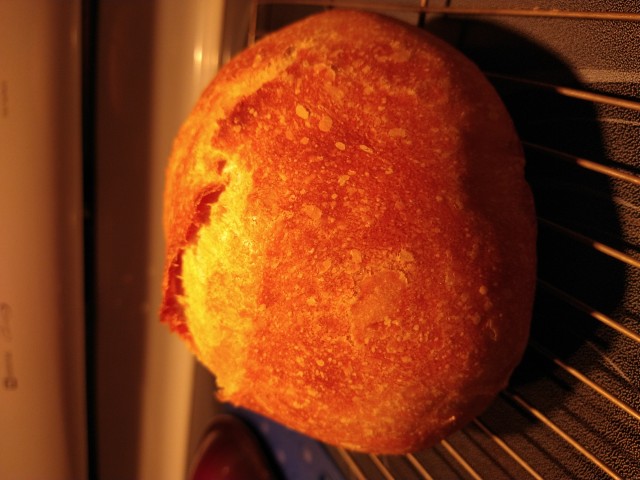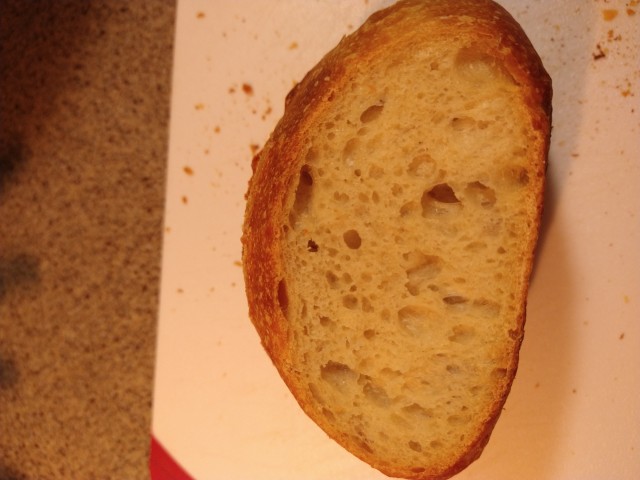Awhile back I was given some starter and made, among other things, a couple pan loaves. They were fine. Yippee posted a link to Susan's easy sourdough loaf recipes here, (recipe here), and I thought I'd try the 63% hydration. First attempt turned out pretty well. I didn't have a razor blade and couldn't drag a knife across the dough because it was inside a bowl, so the slashes aren't deep enough. The dough came out quite wet for 63%. It was dry after mixing, but steadily got stickier. The meat slicer made some unpleasant noises while cutting through the bottom crust. But, all's well that ends well and it tasted delicious.


- Moe C's Blog
- Log in or register to post comments
I have made an evolving version of Susan's Simple Sourdough for many years. I still title my formula simple SD, although at this point I've tweaked it for the volume and hydration I am looking for I couldn't say it is anything more than inspired by one of the original formulas. My most current version is 82% hydration. I always liked her keep it simple approach.
Thank you, Occidental. I'm still debating on whether I want to bother with sourdough (although the waffles are keeping me in the game). This loaf tasted a lot like Jim Lahey's no-knead, lightly-yeasted bread. Perhaps, since I want the flavour to be mild, there is no great advantage to using sourdough. On the other hand, I can't seem to quit. 😊
I was happy with overnight poolishes and often a retarded fermentation but I wanted to bake rye breads. If you have more than a token percentage of rye you need the acid from sourdough to protect the pentosans from releasing water into the dough.
Maintaining the culture isn't a big deal. I feed it weekly, usually 12 hrs before starting the the levain for the next loaf. It will survive 4-5 weeks in the fridge if I'm away; when I get back 3 feedings is usually enough to get the culture lively again.
Rye Culture 12 hrs after a Feeding
Louis, I have only ever used small amounts of rye, but I will keep that in mind.
I suppose what I dislike about sourdough is the interminable waiting.
The time frame for sourdough bread in most cases is about the same as for yeasted breads, if you don't count feeding the starter 12 hrs before you start mixing the levain. As long as the rye is 60% or les you can slice the bread when it cools (usually about 2 hrs), the same as for yeasted breads.
For 60 - 70% rye, rest a full day before slicing to allow the bread to set and the flavor to develop.
For 80% rye and above, 2 full days to set (some people go 3 days).
These waits are because of the rye, not the sourdough.
I'm with you about the waiting. I much prefer the reliability and predictability of dry yeast. I use sourdough for rye breads and I have had many instances of having to bake before fully risen because I couldn't wait any longer. And, rye dough supposedly doesn't care for the retard in the fridge like wheat doughs can tolerate; probably gives more time for starch breakdown.
I once ran out of time and put rye loaves in the fridge to proof overnight. It didn't end well, and there is a note in the formula now not to retard the proof.
Rye is more finicky than wheat doughs, but the artisan bakeries here bake white breads as good for better than mine, but they may make a low-rye loaf once a week. So I alternate weekly between Hamelman's Workday 100% Whole Wheat for my wife and various ryes for me.
You pass the audition!
From the (skinny) king.
I don't know about rye sourdough. For my sourdough bread, using baker's flour, atta, whole spelt etc I don't wait for the starter at all. I keep it in the fridge and use it straight from the fridge, then feed it and let it sit (alongside the fermenting doigh) before putting it back in the fridge ready for next time.
I learned this from Elly's videos and finding it works well for me too.
https://m.youtube.com/watch?v=MifPNIYe4dU&list=PLGli_qxnXLqo9BIxmnXUbzBDpiGGugjWX&index=3&pp=iAQB
I would think that using cold, collapsed starter right from the fridge is just like feeding it. Compared with using a starter at peak activity I would guess that:
It might make a difference that would be noticed in a competition, or possibly in a commercial product. For home use, who cares, and there's some added convenience. And you don't generate any discard.
If I'm on my regular bake-on-the-weekend-with-super-off-peak-electricity rates schedule, I feed the rye culture 12 hrs before mixing the sponge. I generate plenty of discard, which eventually gets turned into pancakes, cornbread, muffins, or a 100% discard loaf which is kind of similar to the Scandinavian ryes that you slice very thin and serve as open-face sandwiches with smoked fish.
The formulas for the discard products are in here: Bread Formulas
I watched Elly's video when I got the starter, and it was very helpful. The waiting I was referring to was the bulk ferment and the proofing. A minor problem in the scheme of things.